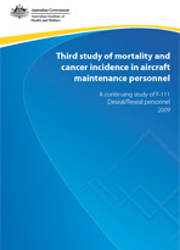Summary
About this report
This report is the third study into mortality and cancer incidence in 873 male personnel involved in the F-111 aircraft Deseal/Reseal (DSRS) programs at RAAF Base Amberley between 1977 and 1999. The incidence rates for DSRS personnel were compared with those of the Australian male population and two comparison groups from RAAF Base Amberley and RAAF Base Richmond.
The first and second mortality and cancer incidence studies were undertaken in 2003 and 2004 respectively as part of the larger Study of Health Outcomes in Aircraft Maintenance Personnel (SHOAMP). The SHOAMP followed a Royal Australian Air Force Board of Inquiry (BOI) that was convened in 2000 following concerns that personnel had raised health risks due to exposure to the chemicals used in the spray sealing of F-111 fuel tanks in 1999.
The second mortality and cancer incidence study utilised the National Death Index (NDI) to identify deaths for the period up to 2001, and the National Cancer Statistics Clearing House (NCSCH) to identify cancers for the period up to 2000.
This third study utilises more recent data - the NDI to identify deaths for the period 19802004, and the NCSCH to identify cancers for the period 1982-2003. In addition, this study separates 1999-2004 mortality data to reduce the bias associated with non-identification of personnel before 1999.
Key findings
Findings from this study are consistent with findings from the previous study.
- Overall cancer incidence in male personnel who were involved in DSRS programs was elevated by 44% when compared with the Australian male population; however the very small number of people involved means that this result was not statistically significant.
- Lip cancer incidence in DSRS personnel was four times as high as in the general Australian male population. This result was statistically significant, but based on only four cases.
- Overall mortality was lower for DSRS personnel when compared with the Australian male population; however, mortality, based on two cases of non-Hodgkin lymphoma, was higher than expected in the 1999-2004 period.
- Cancer incidence in personnel in the two comparison groups (RAAF Base Richmond in New South Wales and RAAF Base Amberley in Queensland) was similar to that of the Australian male population.
- Overall mortality for the two comparison groups was lower than for the Australian male population; these results were statistically significant.
- Comparing the exposed groups (the DSRS personnel) with Amberley personnel showed no significant differences in mortality or cancer incidence.
- Comparing the exposed groups (the DSRS personnel) with Richmond personnel showed increased cancer incidence which was statistically significant. The results for mortality were less clear, with analysis of deaths in the period 1980-2004 showing a statistically significant lower rate, whereas analysis for the period 1999-2004 showed a statistically non-significant higher rate.
Given the number of borderline significant and non-significant findings, the AIHW believes that current data is inconclusive and recommends that this study be repeated in 2011 when more data will be available to provide greater statistical power and to improve certainty about the findings.



